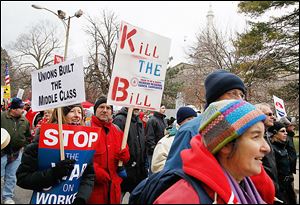
LABOR MOVEMENT
Unions bedeviled by waning influence
Michigan becomes right-to-work-state
3/25/2013
Zimmick
ASSOCIATED PRESS

Demonstrators protest against right-to-work legislation at the State Capitol in Lansing in December. Michigan's shift to right-to-work status is huge blow to the traditionally pro-labor state.
DETROIT — From a sprawling United Auto Workers hall outside Detroit, John Zimmick has seen factories close and grown men cry when their jobs disappear. Through all the economic uncertainties of life in auto country, there has been one constant: the union.
In its nearly 80-year history, Mr. Zimmick’s UAW Local 174 has been tested by bitter strikes, foreign competition, and tenacious opponents. Now comes a new reason for anxiety.
On Thursday, Michigan’s right-to-work law takes effect, a stunning shift in this symbolic capital of organized labor. The historic change is just the latest sign of turmoil in the union movement that has experienced its nationwide membership shrink to its lowest levels since at least the 1930s — a paltry 6.6 percent in the private sector.
With 14.4 million members, unions still can be a potent political force. But protests in recent years over the passage of right-to-work laws in Michigan and Indiana, clashes over collective bargaining in Wisconsin and Ohio, and a sharp drop in union elections across the nation have raised larger questions: Where do unions go from here? How they do mend their battered image? Can they recruit new members? And is organized labor even a movement any longer?
Mr. Zimmick looks for answers in a union hall filled with photos, meeting minutes, and other memorabilia belonging to Local 174’s first president, Walter Reuther, who transformed the UAW into an economic and political powerhouse.
Modern-day realities are far different: With layoffs and some 30 plants closing in the last five years, the local’s ranks have dropped by more than a third, to about 5,000.

Zimmick
There could be even more losses with right-to-work, signed into law in December by Michigan Gov. Rick Snyder. Though employees won’t have to make mandatory payments to unions that represent them in collective bargaining agreements, Mr. Zimmick isn’t expecting the measure to have a major impact. “It’s going to weaken us,” he says, “but it’s not going to kill us.”
Still, Mr. Zimmick worries not just about his local but the fate of all unions.
“It weighs on me every single night before I go to bed,” he says. “Unions don’t have the leverage and power that we used to. It doesn’t mean we won’t regain it. The unions, in my opinion, will come roaring back. ... But the image is terrible right now. The media spin is hurting business and the nonunion workers — there’s animosity and jealousy toward us.”
Membership shrinks
Unions still have influence in blue-state strongholds, but the days are long gone when labor leaders were household names and generous contracts were virtually assured. Both die-hard supporters and workers have abandoned the movement.
John Consentino paid his first union dues at 18, following his father on the Ford assembly line in northeastern Ohio; now 39 years later, he credits the UAW with lifelong security. When friends who don’t belong to unions tell him they’re doing OK, he says he warns them: “Wait until the hiccup, when things aren’t going fine. You’re going to wish you had a union.”
Don McGough lost his job as a union steelworker. He found a new position and a decade later, he voted no when the machinists’ union tried to organize workers at his company, JWF Industries, in Pennsylvania. “There are so many companies that just closed their doors because the union wouldn't budge,” he says.
So, are unions to blame for their dwindling numbers? Yes and no, according to Gary Chaison, an industrial relations professor at Clark University in Massachusetts. He says unions haven’t been nimble dealing with globalization and an increasingly mobile work force.
“I think there still is a labor movement,” he says, “but it’s having a very difficult time finding its relevancy. It’s not sure what to do or how best to serve its members. ... They’re sort of wallowing around without direction. They still have a power in their presence. They don’t have a power in their mission.”
But unions, he says, have been buffeted by forces beyond their control: Improved productivity and technology have reduced the number of workers needed. Nonunion employers have expanded in right-to-work-states. Companies have waged aggressive campaigns to keep unions out. Plant closings make it almost impossible to replenish the number of union members lost.
Potential recruits are wary. “For most workers, joining a union is a risky deal, and it has very little payback,” Mr. Chaison says. “Most unions have not put their hearts and treasuries into organizing. It’s so difficult, and the payoff is minimal.”
Mr. Zimmick knows firsthand. His local tried to organize workers at an auto supplier two years ago. The company, he says, responded by giving workers raises. “They said, ‘Don’t talk to those union guys. We’re going to take care of you.’ ” The campaign didn’t get to the vote stage.
The number of elections to certify unions has fallen dramatically. In fiscal year 2012, there were about 1,200 with more than 83,000 eligible voters, according to the National Labor Relations Board. In 1971, there were more than 7,500 with nearly 550,000 eligible voters.
Silver lining
The silver lining for union organizers: Approval rates have been near or above 60 percent since 2006. In contrast, they were just 50 percent in 1990. In the heyday of unions in 1950, though, 3 of 4 workers voting wanted to sign on.
Union membership declined to 11.3 percent of the work force last year from 11.8 percent in 2011, according to federal statistics. Especially notable was a loss in the private sector even as the economy created 1.8 million jobs.
“I chuckle every time I hear the words Big Labor— 6.6 percent is not big,” says Jefferson Cowie, a Cornell University labor historian, referring to the share of private-sector workers in unions.
And yet, unions still have muscle, capable of raising tens of millions of dollars for political campaigns — largely for Democrats — and getting out the vote. Last fall, the AFL-CIO said it had registered more than 450,000 voters from union households in the previous 18 months.
The union vote was considered critical to President Obama’s victory in states such as Ohio.
While unions representing U.S. manufacturing might — auto and steel — have become smaller, the emphasis in recruiting new members has shifted to the service sector.
The Service Employees International Union, which represents nurses and lower-wage service employees including janitors, security, hospital, home-health, and child-care workers, has doubled in size since 1996, to 2.1 million workers. It says it has added 50,000 workers annually in the last decade.
The union recently organized about 3,000 security officers in Philadelphia commercial office buildings, hospitals, and universities, winning a three-year contract that provides salary increases, health care for full-time workers, and sick days.
Kevin Upshaw, a 46-year-old Army veteran and security officer at the University of Pennsylvania, says the contract will boost his hourly wage from about $13 to about $15. Just an importantly, he says it’ll also reduce medical expenses for his asthmatic wife, which have cost them about $11,000 over the past three years. “That’s taking a big load off our shoulders,” he says.
“The union gives us a lot more stability,” he says. “It’s making this job a career and it’s taking us out of poverty.”
Mr. Upshaw says he had some doubts at first about unions, but the more he heard, the more he liked. “Some people think they’re only out to take our money,” he says. “But like anything in life, you’ve got to pay for any service that’s provided.”
The image of unions has been shaped by skirmishes in the public arena, where membership is nearly 36 percent. Massive protests in two industrial Midwest states in 2011 ended with opposite results.
In Ohio, voters overwhelmingly rejected a law that placed restrictions on public-employee unions. But in Wisconsin, a movement to recall vote Gov. Scott Walker fell short after the GOP-controlled Legislature passed his proposal to effectively end collective bargaining for most public workers.